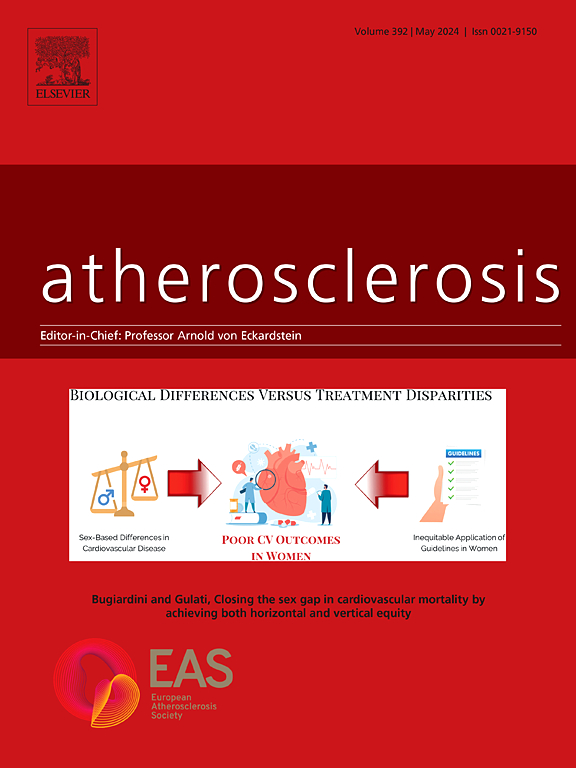Association of Achilles tendon thickness with lipid profile and carotid IMT in patients with familial hypercholesterolemia
IF 4.9
2区 医学
Q1 CARDIAC & CARDIOVASCULAR SYSTEMS
引用次数: 0
Abstract
Background and aims
Familial hypercholesterolemia (FH) is characterized by high levels of low-density lipoprotein cholesterol (LDL-C) and Achilles tendon (AT) thickening. AT thickness (ATT) is useful for diagnosing FH and assessing the risk of coronary artery disease (CAD). Nevertheless, the relationship between AT thickening and lipid profile is not clear. We investigated the association of ATT with lipid Profile and carotid IMT.
Methods
We included 450 patients with clinically diagnosed heterozygous FH. ATT was measured by ultrasonography.
Results
The rate of thickening increased for both AT and carotid-IMT according to age (p < 0.001). In the teens, there was no carotid-IMT thickening, but 39 % of the subjects had a thickened AT. The thresholds of cumulative LDL-C values for AT and carotid-IMT thickening based on ROC curves were 9210 mg/dL∗years (AUC: 0.66, 95 % CI: 0.61–0.72) for ATT and 11,255 mg/dL∗years (AUC: 0.79, 95 % CI: 0.75–0.84) for carotid-IMT. For cumulative LDL-C levels ≥ median, untreated HDL-C level was lower in the AT thickened group than in the non-thickened group (AT thickened: 52 (43–63) mg/dL, non-thickened: 63 (52–72) mg/dL). There was a significant correlation between ATT and cumulative LDL-C (Male: R = 0.48 p < 0.001, Female: R = 0.33 p < 0.001).
Conclusions
We clarified that both cumulative exposure to LDL-C and untreated HDL-C levels were closely related to AT thickening. Our results show that in ultrasonographic assessment, ATT is more useful than carotid-IMT for predicting the degree of lipid deposition in tissues, especially in young adults.

家族性高胆固醇血症患者跟腱厚度与脂质谱和颈动脉IMT的关系
背景和目的家族性高胆固醇血症(FH)的特征是低密度脂蛋白胆固醇(LDL-C)水平高和跟腱(AT)增厚。AT厚度(ATT)是诊断FH和评估冠状动脉疾病(CAD)风险的有用指标。然而,AT增厚与脂质谱之间的关系尚不清楚。我们研究了ATT与血脂和颈动脉IMT的关系。方法纳入临床诊断为杂合性FH的450例患者。超声测量ATT。结果AT和颈动脉- imt增厚率均随年龄增长而增加(p <;0.001)。在青少年中,没有颈动脉imt增厚,但39%的受试者有增厚的AT。基于ROC曲线的AT和颈动脉- imt增厚的累积LDL-C值阈值为ATT为9210 mg/dL∗年(AUC: 0.66, 95% CI: 0.61-0.72),颈动脉- imt为11,255 mg/dL∗年(AUC: 0.79, 95% CI: 0.75-0.84)。对于累积LDL-C水平≥中位数,未经治疗的AT增厚组的HDL-C水平低于未增厚组(AT增厚:52 (43-63)mg/dL,未增厚:63 (52 - 72)mg/dL)。ATT与累积LDL-C有显著相关性(男性:R = 0.48 p <;0.001,女性:R = 0.33 p <;0.001)。结论:累积暴露于LDL-C和未经治疗的HDL-C水平与AT增厚密切相关。我们的研究结果表明,在超声评估中,ATT比颈动脉- imt更有助于预测组织中脂质沉积的程度,特别是在年轻人中。
本文章由计算机程序翻译,如有差异,请以英文原文为准。
求助全文
约1分钟内获得全文
求助全文
来源期刊

Atherosclerosis
医学-外周血管病
CiteScore
9.80
自引率
3.80%
发文量
1269
审稿时长
36 days
期刊介绍:
Atherosclerosis has an open access mirror journal Atherosclerosis: X, sharing the same aims and scope, editorial team, submission system and rigorous peer review.
Atherosclerosis brings together, from all sources, papers concerned with investigation on atherosclerosis, its risk factors and clinical manifestations. Atherosclerosis covers basic and translational, clinical and population research approaches to arterial and vascular biology and disease, as well as their risk factors including: disturbances of lipid and lipoprotein metabolism, diabetes and hypertension, thrombosis, and inflammation. The Editors are interested in original or review papers dealing with the pathogenesis, environmental, genetic and epigenetic basis, diagnosis or treatment of atherosclerosis and related diseases as well as their risk factors.
 求助内容:
求助内容: 应助结果提醒方式:
应助结果提醒方式:


